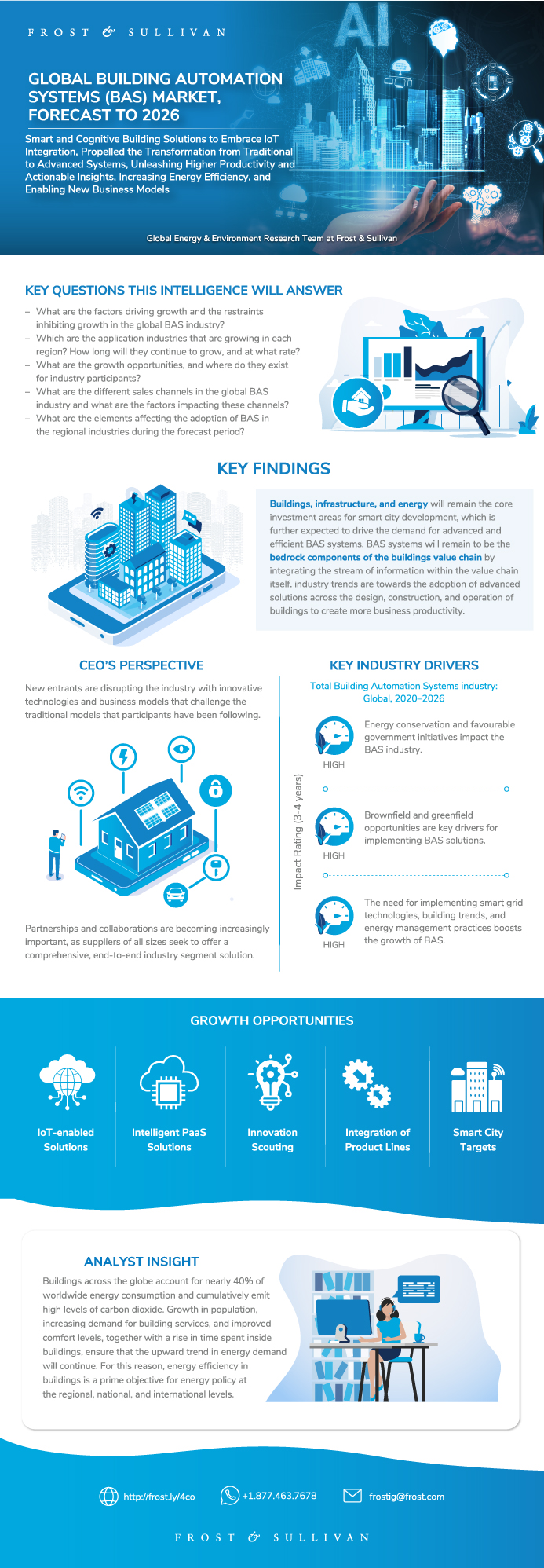Global Building Automation Systems (BAS) Market, Forecast to 2026
Global Building Automation Systems (BAS) Market, Forecast to 2026 Updated Research Available
Smart and Cognitive Building Solutions to Embrace IoT Integration, Propelled the Transformation from Traditional to Advanced Systems, Unleashing Higher Productivity and Actionable Insights, Increasing Energy Efficiency, and Enabling New Business Models
30-Jun-2020
North America
$4,950.00
Special Price $3,712.50 save 25 %
Description
The world building automation systems (BAS) market is poised to grow at a moderate CAGR of 3.4% for the period 2019–2026. The key factors for growth are energy efficiency requisites, energy conservation and favourable government initiatives, rising energy prices, and strict building codes, aiding BAS systems adoption. Regulatory drivers will have a direct impact on the BAS market growth throughout the forecast period. Other drivers impacting the market are brownfield and greenfield opportunities for new and existing building stock and transformation technologies such as artificial intelligence (AI), machine learning (ML), Internet of Things (IoT), data analytics, and the cloud impact on the building automation and building energy management markets.
Building across the globe account for nearly 40% of worldwide energy consumption, and cumulatively emit high levels of carbon dioxide. Growth in population, increasing demand for building services, and improved comfort levels, together with a rise in time spent inside buildings, ensure that the upward trend in energy demand will continue. For this reason, energy efficiency in buildings is a prime objective for energy policy at the regional, national, and international levels. The building stock’s energy-intensive nature is a prime motive supporting the development of a smarter and more efficient building infrastructure, for which BAS is considered a prerequisite asset.
The market has been transitioning from traditional BAS systems with the core control and automation of heating, ventilation, and air conditioning (HVAC) to encompassing intelligent networking of all systems in buildings such as lighting, fire, access and safety, and facilities management. The main aim is to seamlessly integrate them to the overall building management and optimization. The main evolution is in buildings being smarter, interactive, and energy efficient. Occupancy comfort is the main focus of building automation and energy management. Building automation has evolved as a simple control of a complex system, with the convergence of IoT, AI, and intelligent buildings.
High demand for smart BAS systems, integrating operational technology (OT) control network with IT (IoT application), has been seen across countries in North America and Europe and Asian countries such as Singapore, Malaysia, Japan, and China. Emerging economies are expected to witness higher demand for these in the mid-to-long term.
The convergence of technologies will continue to change the dynamics of the BAS market by reducing operating and infrastructure costs and improving the financial optimization of buildings.
Key Issues Addressed
- What are the factors driving growth and the restraints inhibiting growth in the global BAS market?
- Which are the application markets that are growing in each region? How long will they continue to grow, and at what rate?
- What are the growth opportunities, and where do they exist for market participants?
- What are the different sales channels in the global BAS market and what are the factors impacting these channels?
- What are the elements affecting the adoption of BAS in the regional markets during the forecast period?
Author: Neha Tatikota
RESEARCH: INFOGRAPHIC
This infographic presents a brief overview of the research, and highlights the key topics discussed in it.Click image to view it in full size

Table of Contents
Key Findings
Key Findings (continued)
Key Findings (continued)
Key Findings (continued)
Emerging Technology Roadmap
Evolution Towards Intelligent Solutions
Market Engineering Measurements
Market Engineering Measurements (continued)
CEO’s Perspective
Market Overview
Market Overview (continued)
Research Scope
Research Scope (continued)
Research Scope (continued)
Market Definitions
Key Questions this Study will Answer
BAS Communication Protocols
BAS Communication Protocols (continued)
BAS Communication Protocols (continued)
BAS Communication Protocols (continued)
BAS Communication Protocols (continued)
BAS Communication Protocols (continued)
Market Segmentation by Application
Market Segmentation by Region
Market Distribution Channels
Market Drivers
Drivers Explained
Drivers Explained (continued)
Drivers Explained (continued)
Drivers Explained (continued)
Drivers Explained (continued)
Market Restraints
Restraints Explained
Restraints Explained (continued)
Restraints Explained (continued)
Market Engineering Measurements
Market Engineering Measurements (continued)
Revenue Forecast
Revenue Forecast Discussion
Revenue Forecast Discussion (continued)
Percent Revenue Forecast by Region
Revenue Forecast by Region
Percent Revenue Forecast by Application
Percent Revenue Forecast Discussion by Application
Percent Revenue Forecast Discussion by Application (continued)
Market Share
Market Share Analysis
Market Share Analysis (continued)
Competitive Environment
Top Competitors
Competitive Factors and Assessment
Competitive Factors and Assessment (continued)
Top 5 Growth Opportunities
Growth Opportunity 1—IoT-enabled Solutions
Growth Opportunity 2—Intelligent PaaS Solutions
Growth Opportunity 3—Innovation Scouting
Growth Opportunity 4—Integration of Product Lines
Growth Opportunity 5—Smart City Targets
Strategic Imperatives for Success and Growth
North America
Revenue Forecast
Revenue Forecast Discussion
Percent Revenue Forecast by Application
Market Share
Competitive Environment
Europe
Revenue Forecast
Revenue Forecast Discussion
Percent Revenue Forecast by Application
Market Share
Competitive Environment
APAC
Revenue Forecast
Revenue Forecast Discussion
Revenue Forecast Discussion (continued)
Revenue Forecast Discussion (continued)
Revenue Forecast Discussion (continued)
Percent Revenue Forecast by Application
Market Share
Competitive Environment
MEA
Revenue Forecast
Revenue Forecast Discussion
Revenue Forecast Discussion (continued)
Revenue Forecast Discussion (continued)
Revenue Forecast Discussion (continued)
Percent Revenue Forecast by Application
Market Share
Competitive Environment
Latin America
Revenue Forecast
Revenue Forecast Discussion
Revenue Forecast Discussion (continued)
Percent Revenue Forecast by Application
Market Share
Competitive Environment
The Last Word—3 Big Predictions
Legal Disclaimer
Market Engineering Methodology
Abbreviations and Acronyms
Partial List of Other Market Participants
List of Exhibits
List of Exhibits (continued)
List of Exhibits (continued)
Popular Topics
Key Issues Addressed
- What are the factors driving growth and the restraints inhibiting growth in the global BAS market?
- Which are the application markets that are growing in each region? How long will they continue to grow, and at what rate?
- What are the growth opportunities, and where do they exist for market participants?
- What are the different sales channels in the global BAS market and what are the factors impacting these channels?
- What are the elements affecting the adoption of BAS in the regional markets during the forecast period?
Author: Neha Tatikota
| No Index | No |
|---|---|
| Podcast | No |
| Author | Neha Tatikota |
| Industries | Environment |
| WIP Number | MF31-01-00-00-00 |
| Is Prebook | No |
| GPS Codes | 9343-A4,GETE |
 USD
USD GBP
GBP CNY
CNY EUR
EUR INR
INR JPY
JPY MYR
MYR ZAR
ZAR KRW
KRW THB
THB




